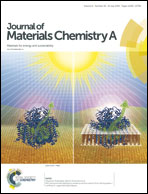Micron-sized monocrystalline LiNi1/3Co1/3Mn1/3O2 as high-volumetric-energy-density cathode for lithium-ion batteries†
Abstract
Low-cost layered lithium transition metal oxides delivering high capacity and moderate rate capability are considered as promising cathodes for next-generation lithium-ion batteries (LIBs). However, the low stacking and compressed density results in lower volumetric energy density of such LIBs compared with that of the first commercialized LiCoO2-based battery. Herein, for the first time, a new strategy is rationally proposed to prepare micron-sized monocrystalline LiNi1/3Co1/3Mn1/3O2via stepwise addition of lithium sources into hydroxide/oxide precursors. As anticipated, the as-prepared 4–8 μm-thick monocrystalline cathode exhibits comparable stacking/compressed density with LiCoO2 electrode, achieving ultrahigh volumetric energy density exceeding 2600 W h L−1, enhanced structural stability and high rate capability in half-cells. Moreover, in full-cell configuration, by using this monocrystalline LiNi1/3Co1/3Mn1/3O2 as the cathode and mesocarbon microbeads as the anode, higher volumetric energy density exceeding 660 W h L−1, enhanced cycling stability and high rate capability are achieved, indicating the expectant merits of the micron-sized monocrystalline cathodes. It is also confirmed that this monocrystalline cathode can mitigate side reactions occurring at the electrode/electrolyte interface and maintain the stability of layered structures upon cycling. This facile tactic provides an innovative insight into preparing high-volumetric-energy-density lithium transition metal oxide cathodes with enhanced electrochemical properties. Moreover, this approach can be readily extended to prepare other types of layered and spinel monocrystalline cathodes with improved volumetric energy density.



 Please wait while we load your content...
Please wait while we load your content...